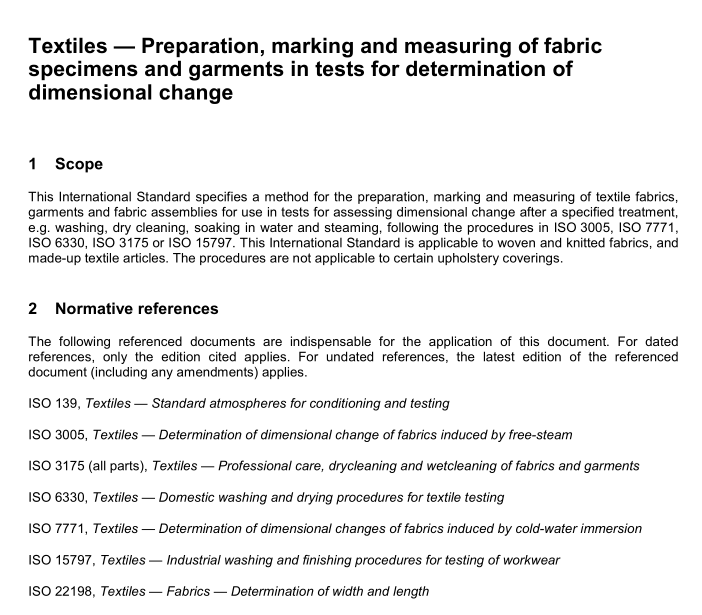ISO 3759 pdf download

ISO 3759 pdf download Textiles — Preparation, marking and measuring of fabric specimens and garments in tests for determination of dimensional change
1 Scope
This International Standard specifies a method for the preparation,marking and measuring of textile fabrics,garments and fabric assemblies for use in tests for assessing dimensional change after a specified treatment,e.g. washing, dry cleaning, soaking in water and steaming, following the procedures in IS0 3005, ISO 7771,ISo 6330,ISo 3175 or ISo 15797.This International Standard is applicable to woven and knitted fabrics, andmade-up textile articles.The procedures are not applicable to certain upholstery coverings.
2Normative references
The following referenced documents are indispensable for the application of this document.For datedreferences,only the edition cited applies. For undated references,the latest edition of the referenceddocument (including any amendments) applies.
ISO 139,Textiles – Standard atmospheres for conditioning and testing
ISO 3005,Textiles —Determination of dimensional change of fabrics induced by free-steam
ISO 3175(all parts), Textiles — Professional care, drycleaning and wetcleaning of fabrics and garmentsISO 6330,Textiles —Domestic washing and drying procedures for textile testing
ISo 7771,Textiles —Determination of dimensional changes of fabrics induced by cold-water immersionISO 15797,Textiles — Industrial washing and finishing procedures for testing of workwear
ISO 22198,Textiles — Fabrics —Determination of width and length
Principle
The specimens are selected to represent the bulk of the textile under examination.Pairs of reference pointsare marked on each specimen, and the distance between each pair of reference points is measured beforeand after specified treatments.
4Apparatus
4.1 Ruler or flexible steel ruler or glass-fibre tape,marked in milimetres and longer than the greatestdimension being measured.
The accuracy of glass-fibre tapes should be verified at least every 6 months.4.2Equipment for marking precise reference points, such as:
a)indelible ink, for use, if necessary, with a template with a measuring grid;b) fine threads of contrasting colour, sewn into the fabric;
c)heated wire for making small holes in thermoplastics materials;
d) staples (suitable for tests during which specimens are not agitated, e.g. for soaking in water).4.3Smooth, flat surface, large enough to lay out complete articles.
4.4Workroom stands, to support garments.
5 Atmospheres for conditioning and testing
The atmospheres used for conditioning and testing shall be in accordance with ISO 139.
6Procedure for fabric specimens
6.1Selection
For fabric piece goods, select specimens representative of the sample. Do not cut specimens from within 1 mof either end of the roll or piece good.Specimens should be taken from areas with different lengthwise andwidthwise yarns. Identify the length direction of the specimens before cutting them out of the sample.
Circular knitted fabrics produced on a body-width machine shall be used in their tubular form. Circular knit,seamless, or knit-to-wear fabric should be tested as a garment.
Tubular knitted samples should be slit and handled in the flat condition in a single layer.6.2Dimensions
Cut specimens, each measuring at least 500 mm x 500 mm, with edges parallel to the length and width of thefabric.For fabrics less than 650 mm in width, full-width specimens may be used and measurements made byagreement between the parties concerned.See IS0 22198 for the measurement of length and width of largetextile items.
lf the fabric can possibly unravel during the test, overlock the edges of the specimen with dimensionally stablethread.
6.3conditioning
Expose the specimen to the conditioning atmosphere (see Clause 5) for at least 4 h, or until a constant massis achieved.
6.4 Marking Place the specimen on the measuring table and make at least three pairs of marks on it in both length and width directions. Ensure that the distance between the marks of each pair is at least 350 mm, that no mark is less than 50 mm from the edges of the specimen and that the measuring points are regularly spaced across the specimen (see Figure 1).
6.5 Method of measuring Lay the specimen flat on the smooth, flat surface (4.3) and remove wrinkles without stretching the specimen. Place the ruler (4.1) on the specimen, taking care to avoid distortion of the specimen. Record the distances between the pairs of marks to the nearest 1 mm.









